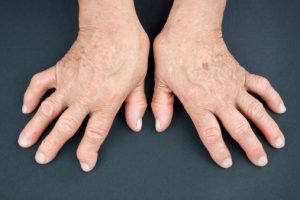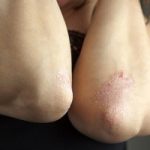
The two conditions share some of the symptoms, that is why it is essential that your doctor conducts the proper testing to avoid misdiagnosis. The good news is, many of the treatments for psoriatic arthritis and rheumatoid arthritis are the same.
Here we will outline the similarities and differences between psoriatic arthritis and rheumatoid arthritis to help you better understand each type of arthritis.
Which is worse: Rheumatoid arthritis or psoriatic arthritis?
Psoriatic arthritis and rheumatoid arthritis are inflammatory conditions that cause joint pain and stiffness. The primary difference is the presence of a rash in psoriatic arthritis. The many similarities between the conditions make it difficult to suggest which is worse.
Both conditions can result in scarring of other organs, including the lungs and heart, and both conditions can increase your risk of osteoporosis as well. Furthermore, destruction of joints can be seen in psoriatic arthritis and rheumatoid arthritis, causing severe disability.
In psoriatic arthritis, the presence of a rash can be embarrassing. This rash is often dry, flaky, and itchy, causing added stress. For this reason, it may appear that in psoriatic arthritis a person gets hit with a “double whammy,” as both their joints and skin are affected. This could lead many to believe that psoriatic arthritis is worse than rheumatoid arthritis.
As mentioned, though, the two types of arthritis are so similar that it is difficult to point at a clear “winner” when it comes to which type of arthritis is worse.
Psoriatic arthritis vs. rheumatoid arthritis: U.S. prevalence

An estimated 1.3 million Americans live with rheumatoid arthritis, and women have higher rates of rheumatoid arthritis than men.
Comparing psoriatic arthritis and rheumatoid arthritis: Signs and symptoms
Signs and symptoms of rheumatoid arthritis are often worse in the morning and flares last for around 30 minutes. Swelling occurs symmetrically (both hands, both ankles, etc.).
Common symptoms in rheumatoid arthritis include joint pain, swelling, stiffness, tenderness, prolonged morning stiffness, and reduced range of motion.
Symptoms often occur in smaller joints, such as the hands, but also present themselves in other parts of the body – like skin, eyes, lungs, heart, kidneys, salivary glands, nerve tissue, bone marrow, and blood vessels.
Symptoms of psoriatic arthritis are similar to other forms of arthritis and include painful swollen joints, stiffness, swollen fingers or toes (look like sausages), tendon or ligament pain, skin rashes and changes to the finger or toe nails, fatigue, reduced range of motion, inflammation and redness of the eyes, and flares of symptoms, meaning they may strike and last for a while and then go away.
Difference between rheumatoid arthritis and psoriatic arthritis: Causes
Not much is known about why the body would start attacking its own healthy cells, but both environmental and genetic factors may be responsible. Research has uncovered some genetic markers that increase a person’s risk of developing psoriatic arthritis.
Rheumatoid arthritis is a type of an autoimmune disease, but it is still unclear as to why or how autoimmune diseases occur. What is known is that the immune system mistakes parts of the body for a virus and begins to attack it. In the case of rheumatoid arthritis, the immune system attacks the synovium.
Rheumatoid arthritis vs. psoriatic arthritis: Risk factors and complications
Risk factors for rheumatoid arthritis include:
- Being a female
- Being over the age of 40
- Having family history of rheumatoid arthritis
- Smoking
- Environmental exposures such as asbestos or silica
- Obesity
Complications of rheumatoid arthritis include the development of osteoporosis, dry eyes and mouth, infections, abnormal body composition, carpal tunnel syndrome, heart problems, lung disease, and lymphoma.
Here’s a look at the factors that can cause psoriatic arthritis:
- Genetics– many people with psoriatic arthritis have a family history of either psoriasis or psoriatic arthritis.
- Physical trauma– this could include a viral or bacterial infection in people with an inherited tendency.
- Stress– anxiety can cause flare-ups or trigger psoriasis.
- Medications– certain medications are known to trigger psoriatic arthritis, including lithium, antimalarials, high blood pressure medications, and the heart drug Quinidine.
While people with psoriatic arthritis experience periods of relief and remission, they too run the risk of complications. For example, a small percentage of those who suffer from psoriatic arthritis develop a condition called arthritis mutilans. This is a very painful and disabling form of psoriatic arthritis. Arthritis mutilans causes extreme damage to the small bones in the hands, leading to permanent deformity.
Diagnosis and treatment options for rheumatoid arthritis and psoriatic arthritis
Proper diagnosis of rheumatoid arthritis involves a look at the patient’s medical history, their symptoms, a physical examination, blood tests to look for antibodies associated with rheumatoid arthritis, and imaging tests to determine any joint damage. The objectives of rheumatoid arthritis treatment include reducing inflammation, relieving symptoms, preventing joint and organ damage, improving physical function and well-being, and reducing long-term complications.
Rheumatoid arthritis can be treated with medications to ease symptoms like pain and stiffness. This may involve anti-inflammatory and pain medications. Other medications can be prescribed to slow down the progression of rheumatoid arthritis, including corticosteroids, biologics, and JAK inhibitors. Surgery may be required if damage is severe, and the joint must be replaced in order to improve function.
To diagnose psoriatic arthritis, your doctor will closely examine your joints for swelling, stiffness, and tenderness, check your fingernails for flaking and other abnormalities, and press the soles of your feet for any tender points. Although there isn’t a specific test for psoriatic arthritis, various forms of testing can rule out other causes of joint pain and stiffness to narrow down the diagnosis. Other tests your doctor may utilize include X-ray, MRI scans, blood test for rheumatoid antibodies – their presence suggests a diagnosis of rheumatoid arthritis and not psoriatic arthritis – and, lastly, a joint fluid test where a doctor inserts a needle to withdraw fluid from the affected joint and check for uric acid to rule out gout.
There is currently no cure for psoriatic arthritis, but treatment options are available. Medical treatments involve the use of anti-inflammatory medications, disease-modifying anti-rheumatic drugs (to slow down progression), immunosuppressants (to tame the immune system), steroid injections (to reduce inflammation quickly), and joint replacement surgery.
Home remedies for psoriatic arthritis include exercising, protecting your joints, maintaining a healthy weight – extra weight adds stress to already painful joints, and using cold and hot packs to reduce inflammation. Diet, too, can play a role in treating psoriatic arthritis.